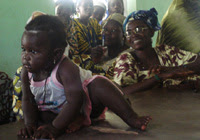 Mali - A l’occasion des élections, les communicateurs traditionnels deviennent messagers de la paix
Mali - A l’occasion des élections, les communicateurs traditionnels deviennent messagers de la paix
Par le Programme des Nations Unies pour le Développement
La cinquantaine, Mossa Al mouamar Ali, dit Moussa Moussa, arbore fièrement son boubou traditionnel cousu à la main par les couturiers de Tombouctou, dont la région est marquée aujourd’hui par une situation sécuritaire précaire.
Comme son père et son grand-père, Moussa Moussa est chef des griots de la région, conteurs d’histoires et dépositaires des traditions orales du Mali.
« Nous jouons notre rôle de griot dans le respect des règles que nous ont léguées nos ancêtres, » dit-il. « Par exemple lorsqu’il y a une querelle entre un mari et sa femme, nous intervenons et nous les réconcilions, si deux villages sont en conflit nous amenons la paix entre eux. Lorsque des gens veulent prendre des décisions importantes, nous pouvons être consultés et nous savons donner notre avis sur les différentes questions. »
En effet au Mali, les griots occupent une place importante dans l’organisation sociale, mariage, naissances, funérailles sont autant d’occasions qu’ils animent et organisent.
« On a déjà fait appel à moi pour intervenir dans des conflits, souvent des problèmes de champs, de terre. Vous savez, certaines personnes étudient le journalisme, d’autres l’informatique nous, voilà ce que nous savons faire et c’est parce que c’est nous que ça marche » Conscientes de leur rôle crucial, les autorités maliennes ont décidé de les associer aux activités de sensibilisation et d’éducation citoyennes précédant le scrutin présidentiel de juillet 2013.
Le vote sera soutenu par un projet d’appui au processus électoral financé par le gouvernement et les différents partenaires du Mali et dont les fonds sont gérés par le Programme des Nations Unies pour le développement (PNUD). Les élections constitueront l’une des étapes clés d’un retour à la paix, la stabilité et le développement.
On estime que le coût des élections s’élèvera à 128 millions de dollars US, dont 50 millions seront financés par le gouvernement malien.
Le PNUD sera également chargé d’appuyer les différents organes de gestion des élections, dont le Ministère de l’Administration territoriale, la Délégation générale des élections et la Commission électorale nationale indépendante dans leur mission d’organisation du scrutin. Il apportera également son soutien logistique au vote et à la mobilisation des électeurs, tout en promouvant paix et dialogue parmi les parties prenantes.
Les griots prendront part à la sensibilisation au vote, conseillant les communautés sur le maintien de la paix et l’harmonie lors du scrutin. Ils activeront leur réseau (Réseau des Communicateurs traditionnels pour le développement –RECOTRADE-) lors de la période pré-électorale.
Le 24 avril, un atelier a été organisé par le PNUD pour informer les communicateurs traditionnels sur les enjeux de la prévention de conflits en période électorale et permettre les échanges sur leur contribution pour promotion de la paix et du dialogue. Tenu à Bamako, l’atelier a réuni 50 griots ainsi que partenaires nationaux et internationaux.
« Il faut dialoguer avec tout le monde, il ne faut exclure personne, ainsi on arrivera à un résultat, » assure Moussa Moussa.
Lors de l’événement, le Représentant résident du PNUD au Mali, Aurélien Agbénonci, a affirmé : « L’organisation des prochaines élections constitue une étape importante dans la résolution de la crise. Votre contribution sera importante pour la construction du futur de ce pays. »
« Nous voyons l’intérêt des peuples, ce que les pauvres gens veulent c’est avant tout la tranquillité, la paix, nous allons faire passer ce message de paix,» ajoute Moussa Moussa.
Pour plus d’informations allez sur www.undp.org
Suivez le PNUD sur Twitter






























